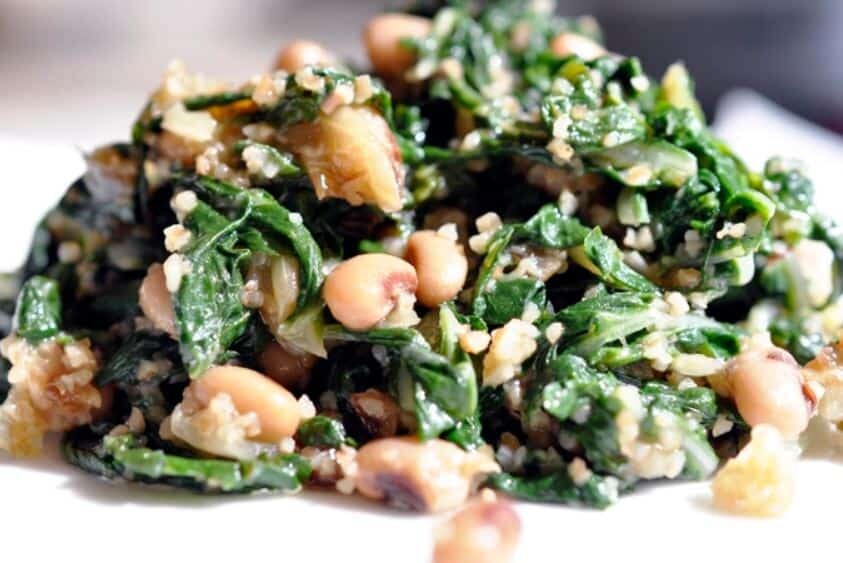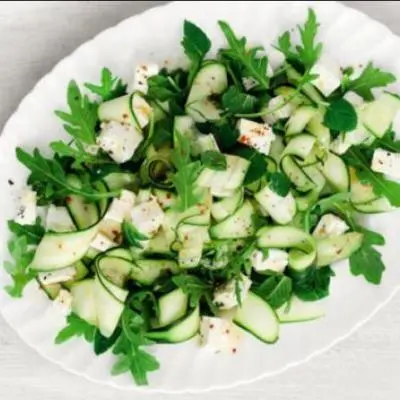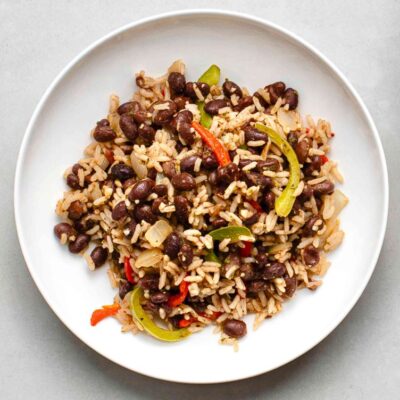Ingredients
-
24 ounce Black-Eyed Peas1 can
-
6 large stalks of Chardchopped, including the stems
-
2 small Onion
-
1 sprig Fresh Rosemary
-
3 tablespoons extra virgin Olive Oil
-
4 cups Water
-
2 Bay Leaves
-
1 teaspoon Sea Salt
-
1 teaspoon Pepper
Steps for Black-Eyed Peas with Chard
|
1
Done
41 Minutes
|
Prepare the brothPut the water in a large pot and add the rosemary, bay leaves, onions, olive oil, salt, and pepper. Bring to a boil, reduce the heat to low, and simmer to produce a flavorful broth, about 40 minutes. |
|
2
Done
16 Minutes
|
Add the ChardRemove the rosemary and bay leaves. Add the chard to the pot, and simmer until tender, about 15 minutes. |
|
3
Done
5 Minutes
|
Stir in the Black-Eyed PeasStrain, reserving 1 cup of the liquid. Return the liquid and the greens to the pot and stir in the black-eyed peas, and let the heat on low for another 2-3 minutes. Canned peas are soft, so be careful not to crush them. Season with salt and pepper. You can serve over rice. Enjoy! |
Additional Info for Black-Eyed Peas with Chard
Black-eyed peas, a type of cowpea, are native to Africa, where they appear in numerous dishes in many countries, but their use has spread throughout the world. The small peas often served over rice, are a mainstay of cooking in the soups and stews of the southeastern United States. Since cooking dried beans or peas might not be possible in many school foodservice situations, this recipe is has canned black-eyed peas.
Content on this page…
About Black-Eyed Peas with Chard recipe
This dish is a super-quick dish that has its roots in Palestine. It is not often that one vegetable provides such a bouquet of options. Black-eyed peas were often overlooked in my kitchen in favor of earthy black beans, buttery cannellini, or plump lima beans. No longer though; black-eyed peas are a new favorite. Sometimes, I like to top them with tahini for an extra layer of flavor.
Black Eyed Beans also known as Black Eyed Peas in some parts of the world, have quite a distinct flavor compared to other beans. Many people find them irresistible once they have tried them and I certainly love them. It is a warm, salad-type main meal and is very tasty. Served with some crusty bread to dip into the garlicky dressing, it is hard not to like this simple preparation.
Weight-Loss helper
As for weight-loss, the black-eyed peas with chard is perfect. It offers a lot of proteins and minerals, perfect for slimming diets, and feeling full a lot more than simple salads. Besides this, it is a vegan recipe, and like all vegan preparations, this one is a great help in losing weight diets and have a healthy meal.
Health Benefits of Black-Eyed Peas with Chard
Black Eyed Peas and Chard is a nourishing and flavorful dish, loaded in protein and micronutrients needed for optimal health. It’s an extraordinary dish for people with blood sugar problems.
Health Benefits of Chard:
This green leafy vegetable is an excellent source of vitamin K, C, E, beta-carotene (antioxidants, and vitamin A precursors), as well as lutein and zeaxanthin which protect our eyes from aging. In Turkey, this vegetable is used as a folk treatment to lower blood sugar. Recent research was conducted to determine the effect of chard on blood sugar. It is confirmed that chard helps lower blood sugar levels, and also plays a role in the regeneration of the cells that secrete insulin.
Health Benefits of Black-eyed peas:
Like other beans and legumes, black-eyed peas are loaded with fiber and proteins. Fibers are the type of carbohydrates that humans can’t digest, and therefore, we don’t absorb it. It is important to us because it feeds friendly bacteria that live in our intestines and help them flourish. Bacteria returns the favor by metabolizing fiber into fatty acids that feed the cells that line our intestine. It helps eliminate toxins by binding to them and creating bulk that moves things out of our digestive tract. Fiber also binds to and eliminates bile salts that are made out of cholesterol.
As per healthline.com, the black-eyed peas support weight-loss, promote digestive health, and enhance heart health. As for vitamins and minerals, it comes packed with folate, copper, thiamine, iron, phosphorus, magnesium, zinc, potassium, vitamin B6, selenium, and riboflavin.
Notes and Tips for Chard
- Chard is perhaps most commonly referred to as Swiss chard (which is one varietal), and it’s related to beets.
- Chard greens look similar to beet greens, but unlike beets, the root of chard is inedible. The green leaves have a grooved, bumpy texture running up a colorful, thick stem. Both parts are edible, but they do cook at different rates. This green vegetable also goes by many other names, including Bright Lights, Chilean beet, mangold, perpetual spinach, Roman kale, silverbeet, spinach beet, and white beet.
- Younger chard leaves can be eaten raw in dishes like salads. The more mature leaves are tougher and best served cooked. As with collard greens and kale, it’s best to remove the stems and ribs from the centers of the leaves because they can be tough and fibrous.
- Some people like to cook the stems separately, often in the same ways one would cook asparagus. One of the best ways to prepare chard is to sauté it. It can also be cooked by moist heat cooking methods, such as steaming, or dry heat cooking methods like grilling or roasting.
- Chard must be thoroughly rinsed before preparing because the leaves can trap dirt. You will also want to cut off any damaged pieces and the very bottom of the stem. To remove the leaf from the stem, fold it in half and cut closely along the stem. You can then prepare the leaves and stems according to your recipes.

















